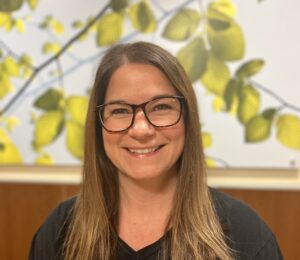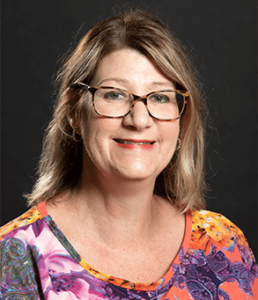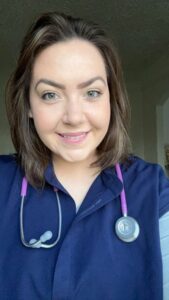As the use of artificial intelligence in healthcare becomes more common, the University of Wisconsin-Milwaukee College of Nursing’s RN-to-BSN program offered through the UW Flexible Option is at the forefront of implementing new skills for graduates, educating the next generation of nurses about AI’s role in patient care.
As the use of AI is a relatively new addition to the nursing curriculum, it’s also an important one. While courses in UW Flexible Option programs are revised to cover emerging trends, students explore AI and its impact on healthcare in NURS 453X–Information Management & Healthcare Technology–in an assignment about quality in healthcare. Specifically, they discuss AI in the context of hybrid healthcare, which recognizes that neither clinicians and AI can function as one team.
Students consider the statement: “The dream potential is such that AI systems will one day unlock a new era of personalized medicine that would go beyond the capability of the entire task force of the specialists. As part of data skyrockets into the superfluous stratosphere of deep data lakes, AI will be an essential tool.” From there, they are asked to explain what that statement means for healthcare, AI, healthcare informatics, and technology.
Learning about AI is pivotal in nursing school because AI can replace manual data collection processes, which improves the quality of care, according to course instructor Jill Saxton. For example, AI can read scans and spot tumors or fractures, alerting a clinician to take a closer look at a patient. AI can also help with things like charting, where a patient may hit several data points that indicate an infection, like sepsis.
“It would cause you, as the nurse, to go and assess and determine if these data points are true and if we have a major infection brewing,” Jill says. “A lot of what AI is doing is behind the scenes, but it’s helping us with alerts and flagging things so that the nurse knows to look deeper or notify providers. It could be life-saving, because if it’s something like sepsis, the sooner it’s discovered, the more likely our patients can get treated and recover.”
AI can help streamline processes and document items faster than humans. For example, blood pressure machines in hospitals automatically document data into a patient’s chart, eliminating the need for manual data entry. The system can also flag patients who have high or low blood pressure for treatment.
“We’ll hopefully streamline the care that we give and allow nurses more time to care for patients, instead of documenting and searching data to look for trends,” Jill says.
AI is a significant asset in population health. In the case of illnesses like food poisoning, which could strike a large number of people, AI can gather data showing that a large number of sick people all ate at the same place. It can help organizations like the Centers for Disease Control and Prevention (CDC), local communities, and health departments collect and use data to track outbreaks of communicable diseases quickly.
AI can also assist nurse informatics, who work with technology and computer programmers to bridge the gap between the people writing the programs and the nurses who actually use them. Simple things like streamlining documentation for nurses and the programs they use can pave the way for quality improvement, Jill says.
While AI can help make processes smoother, there are some obvious disadvantages. “Everything can’t be just taken at face value,” Jill warns. “You have to go back and double check the data to see that things are accurate and that we’re responding correctly to what the AI is finding. You can’t just assume that it’s all 100 percent accurate.”
And for that reason, AI is only an augmentation of healthcare currently.
“It’s always going to take human interaction to fully assess people and to ensure there’s not an error in the data collection. We’d always have to double check it,” Jill adds.
As AI technology evolves, so will the education that nurses need to provide great care. While the UW Flexible Option RN-to-BSN program is in the early stages of addressing AI in nursing courses, Jill says she anticipates that in the next few years, students will be using it more for projects, ultimately preparing for a larger impact on healthcare.
Are you interested in getting your BSN so that you can better help your patients and the community? For more information about this program, contact an enrollment adviser.





